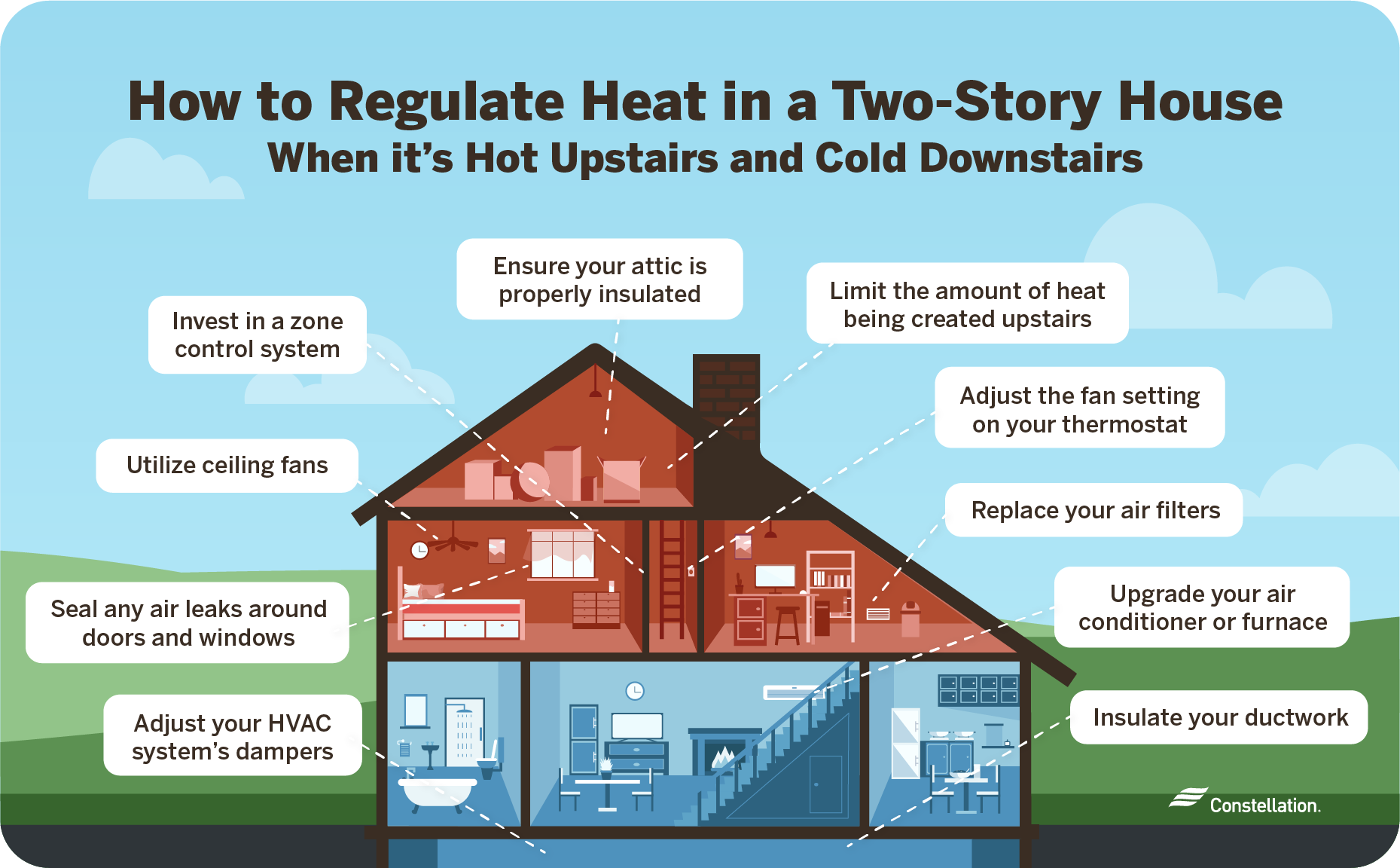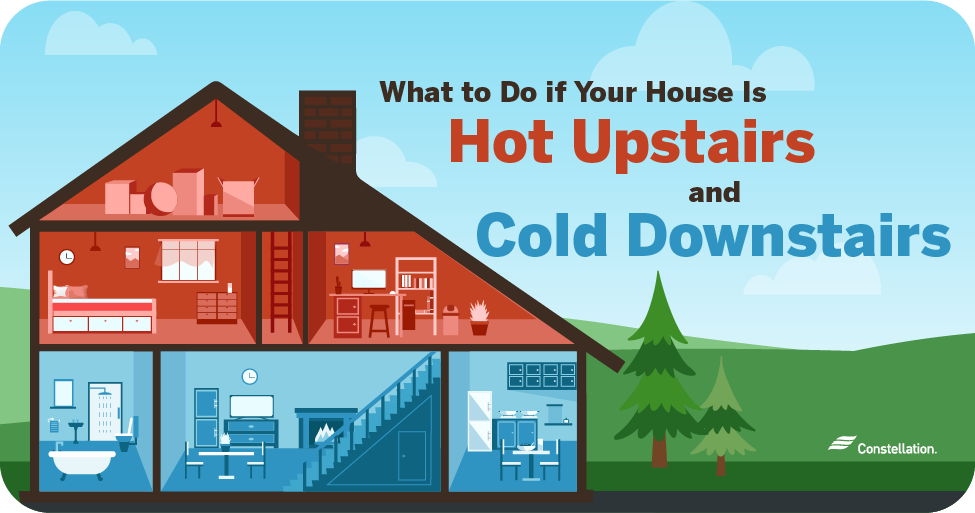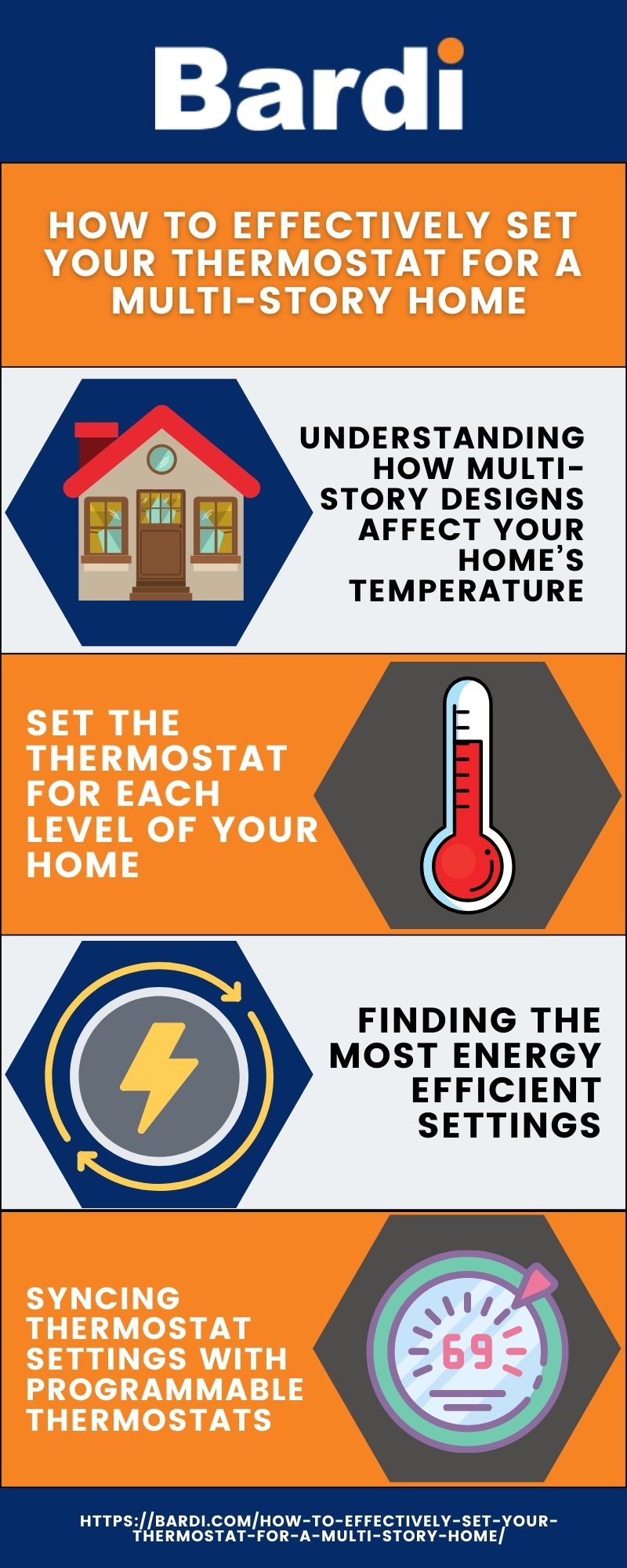Check Best Thermostat Pricing in Amazon
** As an Amazon Associate, I earn from qualifying purchases.
Set the upstairs thermostat 2-3 degrees warmer than the downstairs during summer. Do the opposite in winter for optimal comfort.
Balancing the temperature between upstairs and downstairs can be challenging. Proper thermostat settings can significantly enhance comfort and energy efficiency in your home. During summer, setting the upstairs thermostat slightly warmer helps counteract rising heat. In winter, a cooler setting upstairs takes advantage of natural heat rising from downstairs.
This method ensures consistent and comfortable temperatures throughout your home. Optimizing thermostat settings not only improves comfort but also reduces energy bills. Implementing these adjustments can lead to a more balanced and pleasant living environment. Ensure regular HVAC maintenance to keep your system running efficiently.

Credit: arcticairincsc.com
- Introduction To Zoned Temperature Control
- Assessing Your Home's Layout
- Types Of Thermostats For Multiple Floors
- Setting Up Your Thermostat System
- Optimizing Temperature Settings
- Balancing Temperatures Between Floors
- Energy Efficiency And Cost Savings
- Maintenance Tips For Peak Performance
- Advanced Techniques And Upgrades
- Common Mistakes To Avoid
- Frequently Asked Questions
- Conclusion
Introduction To Zoned Temperature Control
Zoned temperature control allows you to manage different areas of your home independently. This is especially useful for homes with multiple levels. The thermostat settings can be customized for each zone, enhancing comfort and energy efficiency.
By creating zones, you can address unique heating and cooling needs. This is crucial for maintaining consistent temperatures upstairs and downstairs.
The Basics Of Zoning
Zoning involves dividing your home into distinct areas. Each zone has its own thermostat. This allows you to control the temperature independently in each area.
- Zone 1: Typically covers the downstairs area.
- Zone 2: Usually includes the upstairs area.
Zoned systems utilize dampers within the ductwork. These dampers open and close to direct airflow to different zones.
Smart thermostats often support zoning. They can be programmed to adjust temperatures based on your schedule and preferences.
Benefits For Upstairs And Downstairs Comfort
Upstairs and downstairs areas often have different temperature needs. Heat rises, making upstairs warmer than downstairs.
Zoning systems address this by allowing different settings for each level. This ensures consistent comfort throughout your home.
| Downstairs | Upstairs |
|---|---|
| Cooler in summer | Warmer in winter |
| Less sun exposure | More sun exposure |
| Lower heat retention | Higher heat retention |
Energy efficiency is another benefit. You can save on energy bills by heating or cooling only the zones in use.
Customized comfort enhances your living experience. Each family member can enjoy their preferred temperature in different areas.
Assessing Your Home’s Layout
Understanding your home’s layout is key for setting thermostats upstairs and downstairs. It ensures efficient temperature control and energy savings. A well-planned layout assessment can help identify and address temperature disparities between floors. Let’s delve into the specifics.
Understanding Heat Distribution
Heat distribution in a home depends on multiple factors. These include the size and shape of rooms, insulation quality, and window placements. Hot air rises due to its lighter density, making upstairs warmer than downstairs. To balance this, assess each room’s heat sources and airflow patterns.
- Identify heat sources like radiators, fireplaces, and windows.
- Check for drafts or poor insulation areas.
- Evaluate the placement of vents and returns.
Proper understanding of heat distribution helps in setting thermostats effectively. It ensures both floors remain comfortable and energy-efficient.
Identifying Problem Areas
Identifying problem areas is crucial for effective thermostat settings. Certain spots in your home may experience significant temperature fluctuations. Recognizing these areas can help you address them more effectively.
| Problem Area | Potential Solution |
|---|---|
| Drafty Windows | Install weather stripping or thermal curtains. |
| Insufficient Insulation | Add or upgrade insulation in walls and attics. |
| Blocked Vents | Ensure vents are open and unobstructed. |
By addressing these problem areas, you can achieve better temperature control. This makes your home more comfortable and energy-efficient.
Types Of Thermostats For Multiple Floors
Setting the thermostat for multiple floors can be a challenge. Different types of thermostats can make this easier. Understanding these options helps you achieve the perfect temperature in your home.
Manual Vs. Programmable Thermostats
Manual thermostats are simple and straightforward. You set the temperature manually. These are good for smaller homes or spaces with consistent usage.
Programmable thermostats offer more control. You can set different temperatures for different times of the day. This is useful for homes with varying temperature needs. For example, you can set a cooler temperature for the night and a warmer one for the day.
Smart Thermostats And Zoning
Smart thermostats take convenience to the next level. They connect to your Wi-Fi and can be controlled via a smartphone app. They learn your schedule and adjust temperatures automatically. This saves energy and ensures comfort.
Zoning systems allow you to divide your home into different zones. Each zone can have a different temperature. This is perfect for multi-story homes. You can set different temperatures for upstairs and downstairs.
Combining smart thermostats with zoning provides ultimate control. You can manage each zone from your phone, ensuring every part of your home is comfortable.
| Type of Thermostat | Key Features |
|---|---|
| Manual | Simple, Easy to Use, Cost-Effective |
| Programmable | Schedule Settings, Energy Saving, More Control |
| Smart | Wi-Fi Enabled, Remote Control, Learns Schedule |
| Zoning | Different Temperatures for Different Zones, Ideal for Multi-Story Homes |
Setting Up Your Thermostat System
Setting up your thermostat system correctly ensures a comfortable home. It also helps save energy. This guide will help you set up thermostats for both upstairs and downstairs areas.
Installing Multiple Thermostats
Installing multiple thermostats allows you to control the temperature in different zones. This is very useful for multi-story homes.
- Choose the right spot: Place thermostats away from direct sunlight and drafts.
- Mounting: Install the thermostat at eye level for easy access.
- Wiring: Connect the thermostat to your HVAC system according to the manual.
A table can help you understand the benefits of multiple thermostats:
| Feature | Benefits |
|---|---|
| Energy Efficiency | Lower energy bills |
| Comfort | Customized temperature zones |
| Control | Remote access via smartphone |
Configuring Your Zoning System
Configuring your zoning system is the next step. This ensures each area maintains its desired temperature.
- Set Zones: Divide your home into zones like upstairs and downstairs.
- Assign Thermostats: Assign a thermostat to each zone.
- Program Schedules: Set different schedules for each zone based on usage.
Follow these tips to get the most out of your zoning system:
- Use smart thermostats: They offer advanced features like learning your schedule.
- Regular maintenance: Keep your HVAC system in good condition for optimal performance.
- Monitor energy usage: Check your energy bills to see if the zoning system is effective.
Setting up your thermostat system properly can lead to a more comfortable and energy-efficient home.
Optimizing Temperature Settings
Optimizing your thermostat settings can greatly improve comfort and energy efficiency in your home. By understanding how to set temperatures upstairs and downstairs, you can ensure a balanced and comfortable environment. Let’s explore some key strategies for achieving the perfect temperature throughout your home.
Seasonal Adjustments
Seasonal adjustments are crucial for maintaining comfort and efficiency. In the winter months, set your thermostat to a lower temperature upstairs since heat rises. This helps save energy and keeps the lower floors warmer.
During the summer months, set the thermostat downstairs to a cooler temperature. This ensures the cool air circulates upwards, balancing the overall temperature. Here’s a simple table for reference:
| Season | Upstairs Temperature | Downstairs Temperature |
|---|---|---|
| Winter | 65°F (18°C) | 68°F (20°C) |
| Summer | 75°F (24°C) | 72°F (22°C) |
Time-of-day Settings
Adjusting your thermostat settings based on the time of day can also enhance comfort and efficiency. During the daytime, set the downstairs thermostat slightly lower if you spend most of your time there. This keeps the main living areas comfortable.
In the evening, when you’re upstairs, set the upstairs thermostat to a comfortable level. This ensures your bedrooms are cozy for a good night’s sleep. Consider the following settings:
Check Best Thermostat Pricing in Amazon
** As an Amazon Associate, I earn from qualifying purchases.
- Daytime: Downstairs – 70°F (21°C), Upstairs – 68°F (20°C)
- Evening: Downstairs – 68°F (20°C), Upstairs – 70°F (21°C)
Using a programmable thermostat can simplify these adjustments. Set different temperatures for various times of the day to automate the process.
By carefully managing your thermostat settings, you can create a comfortable and energy-efficient home environment year-round.

Credit: blog.constellation.com
Balancing Temperatures Between Floors
Balancing temperatures between floors can be a challenge. Heat naturally rises, making upstairs rooms warmer. Effective thermostat settings can help you achieve even temperatures throughout your home.
Strategies For Even Heating And Cooling
Use these strategies to balance the temperatures between upstairs and downstairs:
- Install a zoned HVAC system: This allows separate temperature settings for each floor.
- Use ceiling fans: They help circulate air, maintaining an even temperature.
- Adjust vents: Open or close vents to control airflow to different floors.
- Install a programmable thermostat: Set different temperatures for various times of the day.
Dealing With Heat Rising
Heat rising can make upstairs rooms uncomfortable. Here are some tips to manage this issue:
- Close blinds and curtains: This reduces heat gain from sunlight.
- Install attic insulation: It prevents heat from entering the upstairs rooms.
- Use attic fans: These help to exhaust hot air from the attic.
- Run the air conditioner: Set the thermostat to a lower temperature during hot days.
| Upstairs | Downstairs |
|---|---|
| Use ceiling fans | Install programmable thermostats |
| Close blinds | Adjust vents |
| Add insulation | Use zoned HVAC system |
Energy Efficiency And Cost Savings
Optimizing your thermostat settings for both upstairs and downstairs can lead to significant energy efficiency and cost savings. By understanding how to adjust your thermostat correctly, you can reduce energy waste and maximize the performance of your heating and cooling systems. This not only helps the environment but also keeps your utility bills in check.
Reducing Energy Waste
One of the key benefits of proper thermostat settings is reducing energy waste. Here’s how you can achieve that:
- Set different temperatures for each floor: Heat rises, so upstairs will naturally be warmer. Adjust your thermostat accordingly.
- Use programmable thermostats: Schedule different temperatures for different times of the day to avoid unnecessary heating or cooling.
- Close unused rooms: Shut the doors of rooms that are not in use to prevent wasting energy on those spaces.
Maximizing System Performance
To ensure your HVAC system runs efficiently, follow these tips to maximize system performance:
- Regular Maintenance: Schedule regular check-ups for your heating and cooling systems to keep them running smoothly.
- Proper Insulation: Ensure your home is well-insulated to maintain consistent temperatures and reduce strain on your HVAC system.
- Use Ceiling Fans: Ceiling fans can help circulate air, making your home feel cooler in summer and warmer in winter.
By implementing these strategies, you can make your home more comfortable and energy-efficient, while also saving on your utility bills.

Credit: blog.constellation.com
Maintenance Tips For Peak Performance
Maintaining your thermostat is key to ensuring your home stays comfortable year-round. Regular maintenance can prevent unexpected issues and save you money. Follow these tips to keep your thermostat running smoothly and efficiently.
Regular Check-ups
Regular check-ups are essential for thermostat efficiency. Inspect the thermostat every few months to ensure it’s clean and functioning.
- Dust the thermostat to prevent dirt buildup.
- Check the battery and replace it annually.
- Ensure proper placement; keep it away from direct sunlight.
Troubleshooting Common Issues
Troubleshooting common issues can help you avoid costly repairs. Here are some tips:
- If the thermostat is unresponsive, check the power source.
- If the temperature reading is off, recalibrate the thermostat.
- Reset the thermostat to fix minor glitches.
| Issue | Solution |
|---|---|
| Thermostat not turning on | Check batteries and circuit breaker |
| Inaccurate temperature readings | Recalibrate or reposition the thermostat |
| Unresponsive buttons | Reset the thermostat or check for firmware updates |
By following these maintenance tips, you ensure your thermostat remains in peak condition, providing you with optimal comfort and efficiency year-round.
Advanced Techniques And Upgrades
Setting your thermostat upstairs and downstairs can be tricky. Advanced techniques and upgrades can make it easier. These methods help you maintain a comfortable home year-round.
Incorporating Smart Home Devices
Smart home devices can simplify managing temperatures. They offer precise control and automation.
- Smart Thermostats: These devices adjust temperatures based on your habits. They can be controlled remotely via smartphone.
- Smart Vents: These vents open and close automatically. They help distribute air evenly throughout your home.
- Room Sensors: These sensors monitor temperature and occupancy. They send data to your smart thermostat for better control.
Combining these devices creates an efficient system. It ensures every room in your home stays comfortable.
Considering System Upgrades
Upgrading your HVAC system can improve comfort and efficiency. Here are some options to consider:
- Dual-Zone HVAC Systems: These systems have separate controls for different areas. They allow you to set different temperatures upstairs and downstairs.
- Variable-Speed Fans: These fans adjust their speed based on your needs. They provide better airflow and reduce energy consumption.
- Energy-Efficient Units: Newer HVAC units use less energy. They keep your home comfortable while lowering utility bills.
Upgrading your system ensures better temperature control. It also enhances overall energy efficiency.
These advanced techniques and upgrades make managing your home’s temperature easier. They ensure every room stays comfortable and energy-efficient.
Common Mistakes To Avoid
Setting thermostats upstairs and downstairs can be tricky. Many homeowners make common mistakes that affect comfort and efficiency. Avoid these errors to ensure a balanced temperature throughout your home.
Overlooking Insulation Factors
Insulation is crucial for maintaining temperature. Poor insulation can lead to uneven heating or cooling. Make sure your home is well-insulated. This helps in keeping the desired temperature stable.
Check for gaps in windows and doors. These gaps can cause heat loss or gain. Seal them properly to improve insulation. This is especially important for rooms with thermostats.
Ignoring Ductwork Issues
Ductwork plays a vital role in air distribution. Problems in ductwork can lead to uneven temperatures. Ensure that your ducts are clean and free from obstructions.
Inspect for leaks in the duct system. Leaks can cause air to escape, making your HVAC system work harder. Seal any leaks you find to improve efficiency.
Consider professional duct cleaning. Dust and debris in ducts can block airflow. Clean ducts ensure better air circulation and balanced temperatures.
| Common Mistake | Impact | Solution |
|---|---|---|
| Poor Insulation | Uneven Heating/Cooling | Seal Gaps, Improve Insulation |
| Duct Leaks | Air Loss, Inefficiency | Seal Leaks, Clean Ducts |
By avoiding these common mistakes, you can ensure a comfortable and energy-efficient home. Proper insulation and ductwork maintenance are key to achieving balanced temperatures.
Frequently Asked Questions
What Is The Most Efficient Way To Set Upstairs And Downstairs Thermostats?
Set the upstairs thermostat 2-3 degrees higher than downstairs. Heat rises, ensuring efficient temperature control and energy savings.
How To Set Thermostat For A Two Story Home?
Set the upstairs thermostat 2-3 degrees warmer in summer and cooler in winter. Ensure even airflow throughout the house.
Should Upstairs And Downstairs Ac Be Set At The Same Temperature?
It’s best to set upstairs and downstairs AC at different temperatures. Warm air rises, so upstairs tends to be hotter. Adjusting temperatures improves comfort and energy efficiency.
How To Fix Temperature Difference Between Upstairs And Downstairs?
Install a programmable thermostat. Use ceiling fans to improve air circulation. Seal windows and doors. Consider zoning your HVAC system. Insulate the attic properly.
Conclusion
Balancing your thermostat settings upstairs and downstairs can optimize comfort and energy efficiency. Follow the tips shared for consistent temperatures. Remember to check and adjust settings seasonally. Your home will feel more comfortable and your energy bills could decrease. Implement these strategies for a more pleasant living environment.
Check Best Thermostat Pricing in Amazon
** As an Amazon Associate, I earn from qualifying purchases.


